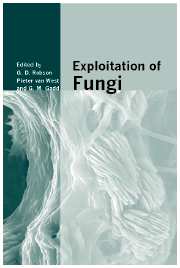Book contents
- Frontmatter
- Contents
- List of contributors
- Preface
- I Comparative and functional fungal genomics
- II Bioactive molecules
- III Protein folding and secretion
- IV Fungal bioremediation
- V Fungal biocontrol of pests
- 14 Fungal control of subterranean pests
- 15 Development of mycoherbicides and evaluation of potential risks (using Stagonospora as a model)
- 16 A novel understanding of the three-way interaction between Trichoderma spp., the colonized plant and fungal pathogens
- 17 Fungal parasites of invertebrates: multimodal biocontrol agents?
- Index
- References
14 - Fungal control of subterranean pests
from V - Fungal biocontrol of pests
Published online by Cambridge University Press: 05 October 2013
- Frontmatter
- Contents
- List of contributors
- Preface
- I Comparative and functional fungal genomics
- II Bioactive molecules
- III Protein folding and secretion
- IV Fungal bioremediation
- V Fungal biocontrol of pests
- 14 Fungal control of subterranean pests
- 15 Development of mycoherbicides and evaluation of potential risks (using Stagonospora as a model)
- 16 A novel understanding of the three-way interaction between Trichoderma spp., the colonized plant and fungal pathogens
- 17 Fungal parasites of invertebrates: multimodal biocontrol agents?
- Index
- References
Summary
Traditional crops are under increasing threat from a number of subterranean pests that have been proven particularly difficult to control. In Europe, these include the larvae of Scarabaeidae (examples include Melolontha melolontha, Amphimallon solstitialis, A. majale, Phyllopertha horticola, Hoplia philanthus), a number of different larvae of Elateridae (for example, Agriotes lineatus, A. obscurus, Limonius spp.) and Curculionidae (Bothynoderes punctiventris, Otiorhynchus sulcatus, for example), Daktulosphaira vitifoliae (Phylloxeridae), as well as the new exotic pest Diabrotica virgifera (Chrysomelidae). Such pests are difficult to control not only because of their hidden niches, but also because of the inherent difficulties of penetrating their habitat with appropriate control agents. In most of the agricultural systems affected in Europe, the application of chemical insecticides is undesirable or impossible. Currently, the use of virulent and ecologically competent strains of insect-pathogenic fungi appears to be the best approach. Fungal pathogens are endemic in pest populations, and they also fulfil the key criteria for biological control agents: effectiveness, auto-dissemination and persistence. In this article, examples of successful use of entomopathogenic fungi Beauveria spp. and Metarhizium anisopliae as preventive control approaches in the subterranean pest control in European agriculture are discussed.
Introduction
Scarabaeidae, Elateridae, Curculionidae, Phylloxeridae, Chrysomelidae and other subterranean pests are of increasing importance in Europe. These pests – especially in their larval stages – cause damage of several billion euros annually to a wide range of economically important crops throughout Europe (Keller & Zimmermann, 2005).
- Type
- Chapter
- Information
- Exploitation of Fungi , pp. 257 - 274Publisher: Cambridge University PressPrint publication year: 2007
References
- 2
- Cited by



